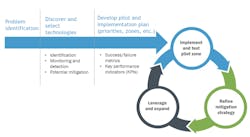Deteriorating water infrastructure and associated repair and replacement costs are among the top concerns for water utilities around the world. Specifically, pipe breaks and water loss are increasing as water mains become more fragile with age. As the AWWA 2020 State of the Water Industry Report points out, more than 3,300 water professionals named deteriorating infrastructure as their top concern, with continued industry optimism toward technological advances and funding.
This is where digital technologies help mitigate these costs. If applied correctly, digital technologies, such as smart sensors and smart water networks, can be used to extend the life of mains before costly repairs are needed and additionally attempt to reduce main breaks before they happen. The challenge to widespread adoption is that utilities lack a proven industry adopted approach that guides them in choosing the right technology that will best fit their needs, identify root causes of pipe breaks, develop and prioritize remedial approaches, and understand associated costs.
Utility Guidance
To provide utilities guidance on how to best apply proven technologies and practices to reduce main breaks and water loss, the Water Research Foundation (WRF) has selected Brown and Caldwell (BC) to lead research project No. 4917, “Utilizing Smart Water Networks to Manage Pressure and Flow for Reduction of Water Loss and Pipe Breaks.” BC is leveraging BC Blue — its method to smart utility implementation, which connects digital technology to create sustainable solutions in a way that provides clarity in a world of extensive data — and subject matter experts in distribution system modeling and failure analysis to execute the project.
The project kicked off in January 2019 with over $1 million in research investment commitments from associations, utilities, and technical providers. The BC project team is collaborating with a wide range of utility and technology partners, starting with four pilots underway in the U.S. and Australia. The project is exploring smart water network (SWN) applications spanning system-wide pressure management, real-time system modeling (digital twins), advanced customer metering to influence usage behavior, and high-frequency pressure monitoring to identify transients.
“We are very excited about working with this project, and [on our utility’s pilot] advanced technology for pressure transient analysis,” Chris Leauber, executive director at the Water and Wastewater Authority of Wilson County, Tenn., said. “We expect the data to provide guidance on how to reduce break frequencies, extending the useful life of our infrastructure and yielding long-term financial benefits as well as improved customer satisfaction.”
This guidance is the goal of WRF No. 4917. It will feature best practices for implementing SWN technology, case studies, and a step-by-step approach to planning, budgeting, design, technology specification and selection, commissioning, and operations and maintenance (O&M).
To begin, the project team has developed a road map to SWN adoption for pilot partners. In general, there are six steps to implement SWN technology solutions:
- Problem identification.
- Discover and select technologies.
- Develop pilot and implementation plan.
- Implement and confirm technologies in pilot zone.
- Refine the mitigation strategy.
- Leverage and expand.
Pilot Implementation
The research project has provided grant funding to four utilities to test the approach and evaluate the SWN technology in 2020. The WRF project is on track to deliver draft final guidelines by April 2021 for WRF review. Each project utility is listed below.
Sydney Water, Australia
Several projects in Sydney Water’s pilot aim to address distribution network issues in water leak detection and water balance. There are four distinct sub-projects that will contribute to the overall project. They are: additional acoustic and pressure sensors added to a district metered area (DMA); additional flow meters added to a selected DMA; smart metering and testing of different metering technologies and a customized metering app; and predictive analytics platform analysis of a variety sensor types.
These projects are designed to test technology and approaches to identify whether these additional near-real-time data can reduce overall water usage, provide early identification and location of significant water leaks, and improve ability to identify small water leaks before they become bursts.
Water and Wastewater Authority of Wilson County, Tenn.
The Water and Wastewater Authority of Wilson County (WWAWC) has focused prior research efforts on using pressure management and district metered areas (DMAs in a reactive mode to locate breaks faster). In this phase, the authority has advanced to a proactive strategy and is piloting transient pressure monitors with a detection range up to 2.5 miles per sensor. These sensors transmit wirelessly in real time to a dashboard where data analytics on suspected transients can be processed. The pilot will include pre- and post-mitigation fatigue analysis to show results.
Water Corporation, Australia
Australia’s Water Corporation is testing real-time hydraulic modeling and analytics. A key approach is the use of advanced hydraulic modeling applications (live modeling and analytics) with a high level of interconnectivity, SCADA, and data historian applications. The piloted technology can enable simulation, query of real-time data, and predictive capability utilizing real-time data. Two pilot areas have been selected to evaluate the value of the technology in different situations.
City of Lakewood, Calif.
The City of Lakewood, Calif., is implementing a pilot to understand transient pressure impacts on water mains and service leaks. The City’s goal is to identify optimum operating pressures during high and low water usage to ensure that optimum pressures are being applied to minimize leakage and potentially reduce consumption. Part of the pilot will lower distribution system pressure to understand response on demand, leakage, and operational issues. Another target is to utilize as much data as possible from a variety of devices the city currently employs on existing leakage detection equipment and its automatic metering system.
The pilot utilities facilitated under this research project are in the implementation phase with case study development beginning at the end of 2020. One highly anticipated result is that the guidance will formulate a methodical approach to help a utility identify the problem it needs to address and then determine the best digital solution. Another expectation is that the research will show utilities can reduce water loss and pipe breaks by simply applying a few well-placed smart sensors to understand their system and modify the pump and valve operations for better management.
What Does the Future Hold?
Digital technologies provide many efficiency opportunities to improve resiliency and increase infrastructure life for utilities. Due to the lack of industry guidance for the application of SWN technologies, adoption has been slow. The number of vendors entering this space has increased dramatically over the past five years, causing confusion for utilities. It can be a challenge for utilities to choose the best partners to address specific staffing, budget, and system needs.
Through cases studies such as Halifax Regional Water Commission’s (Halifax Water) water loss control program, research suggests that pressure management strategies contribute to significant savings. For Halifax Water, annual main breaks and service leaks were reduced by almost 50 percent (from 32 total breaks and leaks down to 17) in the year following adoption of their advanced flow-modulated pressure control.
The project is addressing these challenges by creating a proven guidance manual of best practices for implementing SWN technology. To follow the team’s progress, the WRF website will be updated on a six-month cadence, with pilot data and results for case studies by the end of 2020. The guidance manual will be developed in early 2021 and published thereafter. The project team is continuing to evaluate case studies outside of the four grant-funded research pilots as well as incorporating ongoing industry findings into the study. Utilities piloting smart water technologies that have case studies are encouraged to contact the research project team. WW
About the Author: Erin Culbertson, PE, is a senior project manager at Brown and Caldwell, focused on combining traditional aging infrastructure solutions with innovation and digital applications for clients in both distribution and collection systems. She serves as project manager and a co-principal investigator (PI) on Water Research Foundation (WRF) Project No. 4917, “Utilizing Smart Water Networks (SWN) to Manage Pressure and Flow for the Reduction of Water Loss and Pipe Breaks.”
About the Author
Erin Culbertson
Erin Culbertson, PE, is a senior project manager at Brown and Caldwell focused on combining traditional aging infrastructure solutions with innovation and digital applications for clients in both distribution and collection systems. She serves as project manager and a co-principal investigator (PI) on Water Research Foundation (WRF) Project No. 4917, “Utilizing Smart Water Networks (SWN) to Manage Pressure and Flow for the Reduction of Water Loss and Pipe Breaks.”

